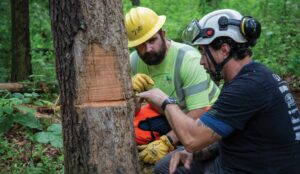
Millions of bats across the U.S. have died due to an epidemic known as white-nose syndrome (WNS). Highly contagious and with no known cure, the disease has wiped out entire colonies and endangered species of bats.
First discovered in 2006 in upstate New York, WNS has spread across the U.S. and into Canada. In 2013, it reached Illinois. The Illinois Department of Natural Resources (IDNR) and Illinois electric cooperatives are partnering to combat the decreasing population and help recover the 13 bat species that call this state home.
“It’s just an awful disease,” says Joe Kath, endangered species program manager at IDNR. “We’ve seen declines of many species that were considered common. The decline in some is greater than 90 percent.”
Of the 13 species, six are listed as endangered or threatened in the state, with three being federally listed. “We’re talking about species that have always been abundant, and now populations have just been nearly wiped out,” Kath says.
The white-nose syndrome name derives from the white fungal growth found on the noses of infected bats. The fungus essentially attacks the bats’ skin membrane while in hibernation – when they are most vulnerable. During this time, the fungus prevents infected bats from properly using their fat reserves, which sustain them throughout hibernation.
“This affects their metabolism,” Kath explains. “They begin to wake up during hibernation, and they’re hungry. … They think it’s spring and it’s time to emerge. They leave the cave in the dead of winter trying to forage for insects. Of course, none are available, and they quickly die.”
Primarily spread from bat to bat, the fungal spores that cause WNS can be carried unintentionally from cave to cave by people as the microscopic spores can get on clothing and footwear.
Bats play an important role, not only in the ecosystem but also in agriculture. Bats can be considered a natural way to control pests since insects are their main source of food. According to the U.S. Geological Survey, bats save farmers more than $3.7 billion a year on pest control, stating that “the actual monetary worth of bats is far greater per year.”
“Bats are the No. 1 consumers of crop pests,” Kath says. “Essentially, farmers are being hit with an expense to control the pests simply because bat populations are declining.”
Seeing those numbers drop, IDNR sought ways to help conserve and recover native Illinois bat species. Bats often roost in trees throughout summer – under peeling bark, in hollows, or in dead or dying trees.
“That’s where females will give birth,” Kath explains. “We call that a maternity colony. In these colonies, hundreds and hundreds of females give birth to their young.”

IDNR decided it needed to replicate these habitats to increase the number of possible locations for bats to roost that are safe and easily accessible. That’s where BrandenBark comes in.
Developed by wildlife biologists at Copperhead Environmental Consulting and Fort Knox Army Installation, BrandenBark is essentially a sheet of fake tree bark that gets wrapped around a pole. It allows bats to crawl under the “bark” and promotes a roosting area.
“The bats are not going to know it’s fake bark, but will see it as a tree,” Kath explains. “These are structures placed on the landscape, in hopes of drawing in bats, where they can form maternity colonies and the females can give birth to their young. In essence, that will help to stabilize the population that continues to dwindle.”
Several years ago, IDNR worked with the University of Illinois to set up two roosting structures in a nature area to see if it would work. The experiment was a success. By the end of summer, several hundred bats were using them. After a DNA analysis of guano (bat excrement) collected at the base of the structures, it was discovered the Indiana bat was utilizing the roosts. This species is listed as federally endangered.
“We could not have hoped for a better scenario,” Kath says. He knew this needed to be a larger-scale project. While IDNR could purchase the BrandenBark, it also needed access to old utility poles and the manpower to set them up.
 In the past, IDNR has worked closely with the Association of Illinois Electric Cooperatives (AIEC) and electric co-ops to help set up osprey nesting platforms throughout the state to help increase the bird’s population. The structure is a square platform on top of an old utility pole. Electric cooperatives donated the old poles and helped install them.
In the past, IDNR has worked closely with the Association of Illinois Electric Cooperatives (AIEC) and electric co-ops to help set up osprey nesting platforms throughout the state to help increase the bird’s population. The structure is a square platform on top of an old utility pole. Electric cooperatives donated the old poles and helped install them.
“Literally within the first season of putting up those platforms, ospreys were already using them and producing young,” Kath says.
Reflecting on the success of the osprey project, Kath approached the AIEC for help.
“When Joe first contacted me and explained the project, I was eager to do what I could to help,” says Brenda Carter, AIEC vice president of regulatory compliance. She acts as the liaison between IDNR and the electric cooperatives. “I think the project is a win/win. Co-ops can reuse old materials and help create habitats at the same time.”
From there, IDNR pinpointed a target site at the Embarras River Bottom State Habitat Area located outside of Lawrenceville in southeastern Illinois. The local area co-op, Norris Electric Cooperative, donated the utility poles, equipment and manpower.
After looking into the project and the impact that bats have on the agricultural industry, Norris Electric Cooperative’s board of directors and Manager Tamara Phillips quickly decided to provide support. “We already had old poles that we could donate. All we had to do was put them in the air,” Phillips says. “It was an easy thing to contribute to help with the project.”

In late November 2021, IDNR personnel and a line crew from Norris Electric erected six bat roosting structures. “Bam, bam, bam. They got all the poles installed,” Kath says. “The poles were up so quick. I was just amazed. There’s no way we could ever do anything like that ourselves. … The crew was just fantastic to work with.”
Kath values the partnership IDNR has with Illinois’ electric cooperatives. Looking at the total cost of the project, he acknowledges and appreciates the role the co-ops play, from donating the utility poles to the expertise and manpower required to put them up safely.
“This is exactly the kind of partnership we’re looking for,” Kath says. “When it comes down to it, the more of these structures we can place throughout Illinois, the better chances bats are going to have to find these structures, which will hopefully result in the long-term recovery of many bat species native to Illinois.”
He explains that the bats first must find the structures, find them suitable for living, and stick around. Of the six poles, Kath is happy to report that five roosts have been a success.
At the base of each pole, there is netting to catch the bat guano. The presence of the guano means the poles are in use, and after DNA analysis, IDNR will be able to tell what species of bats have moved into the roosts. As of publication, DNA results had not been finalized.
“This was the first summer the structures were on the landscape available for bat use,” Kath says. “If one of those structures showed signs of bat use, I would have considered it a success.”
He says from the district biologists to IDNR’s partners at the Illinois Natural History Survey, that “we are all shocked and elated.”

Because all bats are being hit so hard by WNS, regardless of legal protection status, it doesn’t matter which species use the roosts. “Any use is a win for everybody,” Kath explains. “All species need help, and this is exactly the kind of habitat augmentation needed. It is simple, and it works. If this project alone isn’t a testament to how it can work, I don’t know what is.”
Because of the success of the trial run, Kath hopes to start inundating the landscape with these bat structures.
“I’m looking forward to moving toward other parts of the state and working with different co-ops to put up more of these structures,” Kath says. “Without this partnership, I don’t think this would be possible on the scale that we’re looking to do.”
For the future, Kath and district biologists have pinpointed 14 priority target sites in state-owned locations in southern Illinois to place more bat roosts. They will work their way north. They have discovered that ideal locations are in large areas of land set between two habitat types.
While the primary target for roost locations will be on state-owned property, Kath hopes to transition to private land in the future. “We target the areas where we know there’s suitable bat habitat.” He explains that ideal locations would be on 40-plus acres that are home to several different habitats.
For those interested in helping with the project, whether financially or with land, Kath says to email him directly at Joe.Kath@illinois.gov.
Donations can be made through IDNR’s Wildlife Preservation Fund but be sure to contact Kath so he can mark the donation to go toward the bat program. “That way, we know exactly where somebody’s wishes are going to be met,” Kath says, explaining that any financial contribution will go directly to purchasing more BrandenBark sheets.
“A project like this will have such an impact,” Kath says. “Bats don’t know state boundaries and having a project like this in a state with so much bat diversity is going to help recover and stabilize the bat populations throughout the entire Midwest.”
Status of native Illinois bats
Federally endangered (in danger of becoming extinct)
Indiana bat (Myotis sodalis)
Gray bat (Myotis grisescens)
Federally threatened (likely to become endangered)
Northern long-eared bat (Myotis septentrionalis)
State endangered (in danger of becoming extinct in Illinois)
Rafinesque’s big-eared bat (Corynorhinus rafinesquii)
Southeastern bat (Myotis austroriparius)
State threatened (likely to become endangered in Illinois)
Eastern small-footed bat (Myotis leibii)
Currently unlisted
Eastern red bat (Lasiurus borealis)
Hoary bat (Aeorestes cinereus)
Silver-haired bat (Lasionycteris noctivagans)
Big brown bat (Eptesicus fuscus)
Tri-colored bat (Perimyotis subflavus)
Evening bat (Nycticeius humeralis)
Little brown bat (Myotis lucifugus)
Source: Illinois Department of Natural Resources









